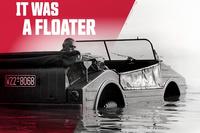If your car has low brake fluid levels (see “Checking Brake Fluid”), it usually means that there’s a leak somewhere in your wheel cylinders or your brake lines, which are the lines that run underneath your car from the master cylinder in your engine compartment to all four tires.
Ideally, you would put your car on a hydraulic hoist so you can walk underneath it to check the brake lines, but if you don’t have one available, you can perform the inspection by jacking the car up, one wheel at a time, and putting jack stands under the car. You can then inspect the underside of the car using a flashlight or work light.
1. Locate the brake lines
The brake lines are connected to each wheel at the brake caliper (the “clamp” over the disc brake), and run into the engine compartment where they connect with the master cylinder. Brake lines can be steel, or rubber, or a combination of both.
2. Check for leaks
Run your hand down each brake line, looking for leaks. If you find any moisture, the brake lines will need to be replaced. Brake fluid is clear and sometimes difficult to see at first glance, so keep a sharp eye out. Most leaks occur at the wheel cylinders where they connect to the lines.
3. Other Warning Signs
If rubber brake lines are cracking or flaking, it’s a sign that they need to be replaced. Rubber lines should also be dry and firm—if they are sticky, soft, spongy, or worn, they will require replacement. Streaks of dried fluid also indicate that leakage is occurring. If your lines have some rust, gently sand them off and see if there are any thin areas on the lines—if an area is thin, there’s a good chance that it may leak later.
Replacing Brake Lines
If you need to replace a brake line, be sure to get a brake line that is the same length as the brake line you’re replacing. To replace the line, follow these steps:
1. Remove the tire where you are replacing the line for easier access.
2. Unscrew the brake line from the line fitting closest to the master cylinder.
3. Remove any mounting bracket clips (these are the brackets that hold the line in place).
4. Disconnect the brake line from the brake caliper.
5. Loosely attach the new brake line to the caliper.
6. Reinstall bracket clips with new hose.
7. Attach other end of hose to the line fitting.
8. Tighten all connections.
9. Bleed all air from the brake system (for more details, see the Bleeding Your Brakes section).
10. Test drive the vehicle to ensure that everything is working normally.
Related Links:
Brake Maintenance: 5 Warning Signs
Brake Failure: Emergency Tips
Brake Maintenance: Checking Brake Fluid
Brake Maintenance: Bleeding Your Brakes
Brake Maintenance: Inspecting and Replacing Discs and Brake Pads
Ideally, you would put your car on a hydraulic hoist so you can walk underneath it to check the brake lines, but if you don’t have one available, you can perform the inspection by jacking the car up, one wheel at a time, and putting jack stands under the car. You can then inspect the underside of the car using a flashlight or work light.
1. Locate the brake lines
The brake lines are connected to each wheel at the brake caliper (the “clamp” over the disc brake), and run into the engine compartment where they connect with the master cylinder. Brake lines can be steel, or rubber, or a combination of both.
2. Check for leaks
Run your hand down each brake line, looking for leaks. If you find any moisture, the brake lines will need to be replaced. Brake fluid is clear and sometimes difficult to see at first glance, so keep a sharp eye out. Most leaks occur at the wheel cylinders where they connect to the lines.
3. Other Warning Signs
If rubber brake lines are cracking or flaking, it’s a sign that they need to be replaced. Rubber lines should also be dry and firm—if they are sticky, soft, spongy, or worn, they will require replacement. Streaks of dried fluid also indicate that leakage is occurring. If your lines have some rust, gently sand them off and see if there are any thin areas on the lines—if an area is thin, there’s a good chance that it may leak later.
Replacing Brake Lines
If you need to replace a brake line, be sure to get a brake line that is the same length as the brake line you’re replacing. To replace the line, follow these steps:
1. Remove the tire where you are replacing the line for easier access.
2. Unscrew the brake line from the line fitting closest to the master cylinder.
3. Remove any mounting bracket clips (these are the brackets that hold the line in place).
4. Disconnect the brake line from the brake caliper.
5. Loosely attach the new brake line to the caliper.
6. Reinstall bracket clips with new hose.
7. Attach other end of hose to the line fitting.
8. Tighten all connections.
9. Bleed all air from the brake system (for more details, see the Bleeding Your Brakes section).
10. Test drive the vehicle to ensure that everything is working normally.
Related Links:
Brake Maintenance: 5 Warning Signs
Brake Failure: Emergency Tips
Brake Maintenance: Checking Brake Fluid
Brake Maintenance: Bleeding Your Brakes
Brake Maintenance: Inspecting and Replacing Discs and Brake Pads









